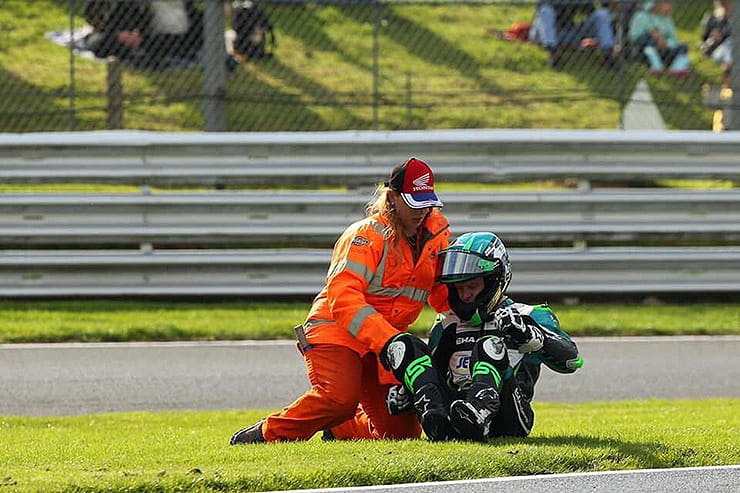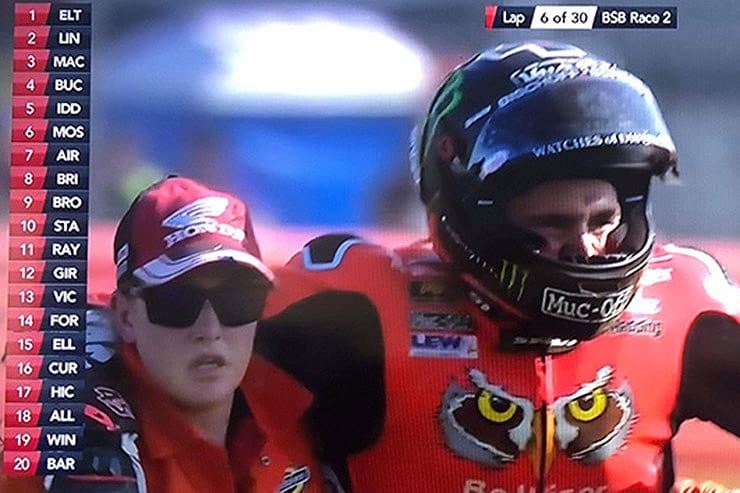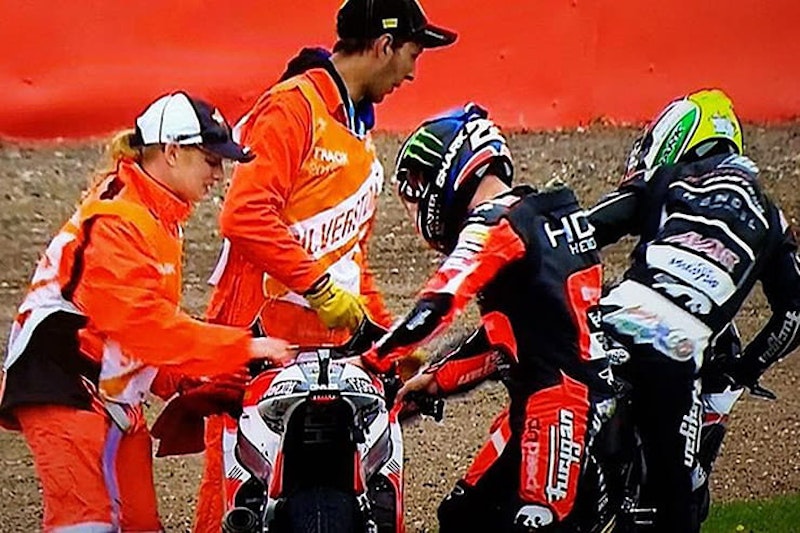Diary of a British Superbike… Marshal
By Laura Maliphant
Motorcycle Journalist and Race Marshall
28.10.2020
A 6:30am alarm call on a Friday morning would normally mean work, but not today, today is an orange army day….
I am Laura Maliphant and I have been a Racesafe marshal for 5 years. It all started for me back in 2015 when a colleague of mine got chatting to me and she said she was off marshalling for the British Superbikes at the weekend. I had to find out more and before I knew it, I had signed up and on 21st February 2016 I was heading to Bedford Autodrome for my Racesafe training course. The day was packed with information and I left super excited for the season ahead! Once you have completed your training course you have to complete 12 days of trainee marshalling alongside an experienced marshal to be fully signed off with a mix of flagging and pick ups. Even when you are signed off you will never be alone, and that’s part of the beauty.
The Racesafe family is fantastic, we are all there to achieve the same goal and for the love of the sport. Marshals are people from all walks of life, you could be assigned to work alongside a teacher, a lawyer and a shop worker, we even had an astrophysicist who joined us on his down time searching the galaxies!
People often ask me why I do it? Three long days, unpaid, out in the elements which can be anything from 30 degrees (while wearing sturdy boots, fire retardant overalls and gloves) through to freezing cold with rain or the occasional snow shower. The answer for me is simple; the people I work with and feeling like a part of the racing family. My passion for racing goes deep, I used to race at club level myself but because of the all-too-familliar ‘funding issues’ I had to give it a rest, so this for me is the next best thing. As a Racesafe marshal you not only get to support the BSB championship, but also the UK rounds of MotoGP and the World Superbike championship. I have had some of the most incredible experiences from standing under a MotoGP Podium to a pillion lap round Knockhill.
I’ve attended the British round of MotoGP since 2008 as a fan but 2016 was my first year as a marshal, and I was lucky enough to sign on at Luffield for an incredible experience. After the Moto 2 race where Johan Zarco took the win, he finished his victory lap by pulling over track side at Luffield. I looked to the Incident Officer (this is the marshal who is responsible for the corner and does the radio communications with race control) who allowed 2 of us to run out to see if he was ok… he was more than ok, he got off his bike and left it in my capable hands while he headed over to the tyre wall to perform his celebratory ‘Flipping Frenchman’ routine. Yes, I was holding the back of Zarco’s bike watching him about 20 feet away, back flipping off the tyre wall! As he walked back, I heard another bike pull up which was our local lad Sam Lowes. He asked me to hold his bike which I did, he ran through the gravel, threw both boots into the crowd and headed back to his bike… and me. He gave me a high five before jumping back on his bike and riding down pit lane. Moments like this cannot be bought, it blew my mind and I knew that I was hooked on marshalling for life.
My first three years as a marshal I was trackside, rotating during the day between flagging and pick-up. These are the two roles that all trainees will start off with. I am happy doing either, flagging holds great responsibility; riders look to you to know if the track is clear ahead, if an incident is coming up, if something is wrong with their bike or if a faster rider is approaching them. Once you start flagging you realise how much they pick up on what you are doing so it is critical to get it right, not only for their safety but for the safety of your fellow marshals.
Above: rescuing James Rispoli. He was grateful.
Pick-up is where I feel most vulnerable and it really gets the adrenaline pumping, having to run out into a gravel trap to pick up a bike and rider which can be scary if a live session going on. Sometimes the bike is badly damaged to the point it needs multiple marshals to lift it and get it clear of the gravel. If heading to a fallen rider, you never know what you are going to see. It could be a rider who is winded and just needs help getting up and moving, but it could also be a rider with a serious injury or unconscious. Every corner has a fully qualified doctor or paramedic on, with a simple signal of an arm straight up with a closed fist, the medic knows they are needed. When marshals are out picking up, there is always one who is the ‘spotter’, they will watch the oncoming traffic and will shout if anything else decides to fly our way. If you hear them shout, you have to just drop and run. A perfect example of this was when Cal Crutchlow had crashed at Brooklands a few years ago and Marc Marquez missed the yellow flag and came flying in. The marshals grabbed Cal and all avoided a potentially serious incident.
The last two seasons for me have been on the recovery team. You will see us flying around the outside of the circuit on taxi bikes to pick up fallen riders who need taking back to the paddock, or in the big recovery vans trackside picking up the crashed bikes at the end of each session. I am very proud to have been the first ever female taxi bike rider for Racesafe. It took riders by surprise at first seeing a ponytail hanging out the back of the helmet. But they are used to it now.
This video shows you what a day on recovery is all about. It is Brands Hatch and the final round of the 2020 Bennetts BSB championship.
Diary of a Bennetts British Superbike... marshal
Welcome to a new series going behind the scenes of the Bennetts British Superbike championship to find out what makes the world's most popular national motorcycle race series such a success.
After getting up at 7am and getting my orange army overalls on, I meet Paul (my marshal buddy for the weekend) at 7:30am on Friday morning, we are the first up and out of the campsite as we needed to make sure that all the kit is dropped out around the circuit for the weekend ahead. Paul has the kit map and I am in the back of the van putting out the right kit at each post. Every post will need to have a combination of sets of flags, number boards and scoops. The number boards are used to show a rider number who has an issue with their bike and needs to stop or has been black flagged, through to a safety car situation where we display the 0 board to show it is on its last lap before the race can continue.
Dropping the kit out usually takes about half an hour depending on the circuit. We then head into pit lane to meet all the Incident Officers (IOs) who have a briefing each morning with Stuart Higgs, Race Director. During this meeting we listen to any information about weather updates, change in timetables and any updates that may be necessary to the smooth running of the day ahead. Once complete we drop of the IOs to their posts to ensure the start of the day can happen on time.
After all marshals and medics are on post we get ourselves into position, this weekend we are based at pit exit. We are covering the first third of a lap of the Brands Hatch Grand Prix layout: Paddock Hill, Druids, Graham Hill Bend and Cooper Straight. There are two other recovery vans who cover the rest of the circuit. We stand trackside for the inspection lap, this is where Stuart Higgs and other key members of race direction head out in the safety cars to do a marshal count, medic count and make sure we are ready for the first practice session. I check the back of the van is ready for pickups, ensuring the ratchet straps are in place and we have a spare scoop on board in case we need to drop one off at a post if theirs has gone off in an ambulance with a rider.
During each session I am sat in the van or stood next to the circuit listening to the radio waiting for any calls about fallen riders or mechanical retirements. If a red flag is needed, then we need to be ready to go trackside and collect the bike. Sometimes we are required to do a fast turnaround, so as we approach the corner I am jumping out the van before it has fully stopped, I run to the back and open the doors, slide the ramp out and turn for the bike, Paul starts to get the bike lined up and then we get it up the ramp as quickly as we can. Once up the ramp I take control of the bike and use the large straps to fasten it in. The straps loop round the rear wheel, under the foot peg, under the handlebar and then ratchet tight to the side of the van. I stay in the back of the van with the bike to make sure it does not move about but also to make sure we do not have any issues such as the bike catching fire which is a chance when dealing with hot crashed bikes that are potentially leaking fuel.
As soon as the bike is loaded, we take the bike to the technical team in the scrutineering bay. They will hold onto the bike if the rider has had to go to the medical centre, or if the rider is ok then the bike can be released back to the team. We can then roll back to pit exit ready for the next call. We can fit up to five 600cc/1000cc bikes in the back of the vans or six of the smaller Honda British Talent Cup bikes. It can be a bit of a squeeze but we make it work. For sidecar recovery we have a couple of ways of getting them back if they cannot be ridden. If leaking oil or full of gravel then we load them onto a flat bed, but if they are ok then the rider takes the steering and the passenger sits backwards with feet up on the front bumper of the van, and we then drive nice a slowly and give them a push back to the paddock. A little scary the first time you have to do it.
During the weekend we had a few fallers at Cooper Straight. Where we were based means we can run on foot to assist the on post marshals. One of the fallers was unable to get up so needed to be scooped. When you need a minimum of four marshals to scoop, they can use the extra help to get the bike clear. The team worked super-fast and had both bike and rider clear of the track and to safety in a matter of minutes! I went to assist as the medics needed extra hands to lift the rider onto the stretcher to get him in the ambulance. Paul and myself got stuck in, taking a corner of the scoop to lift and help get him away quickly and safely. We were then able to clear the bike away from post.
Fridays are usually our quieter days; free practice is for setting up the bikes and getting the riders eye-in for the weekend ahead. Saturday and Sunday are when we are usually busier, this is when riders are pushing harder for good qualifying times, or for that race battle. This weekend was no exception with multiple championships to be decided everyone was giving it their all. I could feel the tension in the air and being stood at pit exit, when the riders were lining up to go out on track, I could see the focus in their eyes. It is something you just can’t experience from your sofa at home.
Marshalling is voluntary however you do get free camping, a meal voucher for each day you are marshalling and normally you would receive a guest pass for each day you marshal as well. This year was a different one due to the marshals having to bubble together, so sadly no guests.
The orange army are always looking for more volunteers and you would be more than welcome. You can apply to join Racesafe here, applications are only open for October, with the training days being held in February before the season starts. This year has been strange but incredible, no fans has been a real shame as the racing has been one of the best seasons so far - multiple race winners through the season, very close battles and championships brought down to the final race.
Share on social media:



